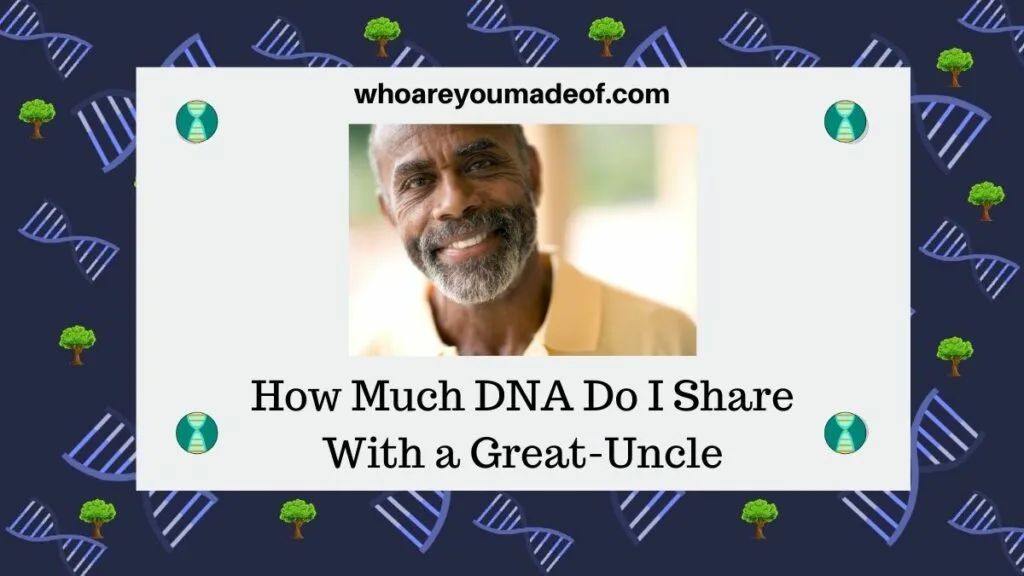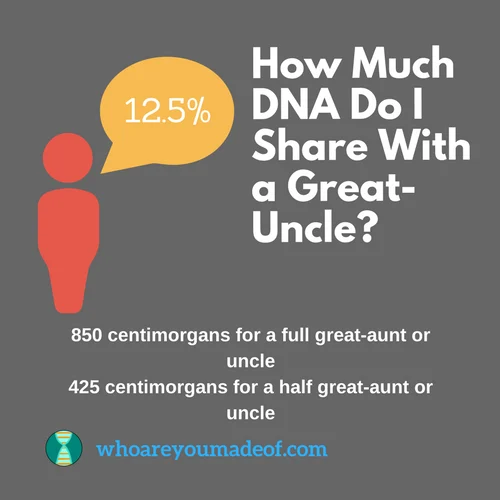In this post, I will explain how much DNA you should share with a great-uncle or a great-aunt. There is a range of shared DNA, measured in centimorgans, that we expect to see between relatives of this distance.
This is important information to know, whether you are trying to figure out how a new DNA match is related to you, or whether your great-aunt or uncle was a full or half-sibling to your grandparent.

But first, we should make sure we are all on the same page about what exactly a great-uncle or aunt is. How are they related to us?
What is a great-uncle or a great-aunt?
A great-uncle or aunt is a sibling of one of your grandparents. It can sometimes be confusing to use the description “great”, since we think of “great”-grandparents being one more generation removed from our grandparents.
A sibling of our great-grandparent is a great-great aunt or uncle. In addition, we would share significantly less DNA with these great-great aunts and uncles.
What is a “half” great-aunt or “half” great-uncle?
This person would be half-sibling of one of your grandparents. Basically, this means that your grandparent shared one parent with this sibling, versus the two parents that full siblings share.
The reason that this is important is that you will share, on average, 50% less DNA when there is a “half” relationship involved. The reason for this is because your grandparent and this half-sibling of theirs shared 50% less DNA than full siblings do since they don’t share both parents.
The result is that the children of these half-siblings, which would be half-cousins, would share 50% less DNA than “full” first cousins. You can probably see the pattern here.
Will I share DNA with a great-aunt or great-uncle?
Yes! You will always share DNA with your great-aunts or great-uncles, whether they are full or half great-aunts or uncles.
It is not possible for a great-uncle or great-aunt to share absolutely no DNA with their great-niece or nephew. Our great aunts and uncles are closely related, and therefore must share DNA with us – even if they were half-siblings to our grandparents.
With the knowledge that you will absolutely, always share DNA with a great-uncle, it is important to acknowledge that there is a wide range of how much DNA you will share. You will always share some genetic material, but not always the same amount.
So, how much DNA will I share with my great-uncle?
DNA testing companies report the amount of DNA that we share with our relatives, including our great-uncles and great-aunts, in centimorgans or percentages. We typically share about 12.5% of our DNA with these relatives.
Measured in centimorgans (cMs), we share about 850 cMs with our grandparents’ siblings. If our relative is a half-great uncle or aunt, we would share an average of 425 cMs.
As I mentioned at the beginning of this post, there is a range of shared DNA that we see with almost every relationship distance, and our great-aunts and uncles are no exception to this. We know that we share an average of 12.5% or 850 cMs, but what is the normal range?
You will likely share between about 575-1330 cMs with a full great-uncle or aunt. If your relative is a half-great aunt or uncle, you will likely share between 215-650 cMs.

How to determine if your relative is a full or half great-uncle or aunt?
You may have noticed that there some slight overlap between the ranges that we see for full and half-great uncles and aunts. What does it mean when the relationship isn’t really clear?
If the amount of DNA falls in the very low part of the range for full great-uncle or aunt or the high part for half-great uncle or aunt, you will not be able to determine whether you are full or half-relatives using only the amount of DNA that your relative shares with you.
If you are trying to figure out whether your great-uncle is a half-great uncle or a full great-uncle, having other family members do a DNA test is a great way to get more information to help you find out what you want to know.
For example, if your grandparent or another great-aunt or uncle is available to test, you would be able to compare their DNA with that of your great-uncle. If your parent (the niece or nephew is available to test), this would also be a helpful comparison.
If you don’t have any older relatives to test, sometimes testing one of your siblings can help you determine if you are simply “low sharing” with your great-uncle.
One of your siblings might share more DNA with a great-uncle, which is very common, and this can help you determine if more research needs to be done on your recent ancestry.
For example, if your full sibling shares more DNA with your relative, it might place your relationship “firmly” into the full great-uncle or aunt category. If they share much less than you do, then it can provide further evidence that they might be half-siblings with your grandparent.
Learn about my recommended DNA testing strategy in the following post:
Conclusion
I hope that this post helped you learn a little bit more about your DNA matches, and what to expect as far as shared DNA between you and a great-aunt or great-uncle.
Have you found someone on your DNA match list that you think might fall into this category? Has your great-aunt or great-uncle tested? I would love to hear from you in the comments!
Thank you so much for stopping by!


Nissa
Thursday 17th of August 2023
Is it uncommon for someone to share 20% DNA (1389cms) with a great uncle… most sites have said that he would more than likely be my grandparent instead of great-uncle… so just wondering if it’s possible…
Mm
Saturday 14th of January 2023
Hello I found your article researching about my paternal great aunt(my grandmother’s sister) and 1c1r . I share 19% with my great aunt at 1219 cm across 35 seg and I match her daughter, my 1c1r at 816 across 35 segments. I can’t figure out why I match them so highly. Closer than some of my actually 1st cousins. Is this normal? Thank you!
Amy
Saturday 19th of November 2022
I am trying to determine who my dad's father was. His 23andme showed a man with the same rare paternal haplogroup. I had actually already determined that it was that his father was in that lineage before noticing the haplogroup, simply based on shared DNA matches with my father, my daughter, this and this unknown man but not shared with my dad's half-sister by his mother. Therefore, I know for sure that I am looking at the correct bloodline. This man showed up as a 10.56 match to my father, which is just doubtless more than that of his half-sister's children but more than his half-niece's daughters. What I'm trying to determine at this point is if this man is my father's nephew or great-nephew because that will tell me who my dad's father is. This man is listed as possible 1st cousin or 1st cousin once removed in relation to my father. As he and my father are both male, would he show as a higher percentage than my dad's great-nieces? Any help with this would be greatly appreciated! Thanks in advance 😊
Spencer Bryant
Wednesday 6th of July 2022
Sorry so i believe really half of a great great uncle ?
Spencer Bryant
Wednesday 6th of July 2022
Can you tell me how much cM I would share with a great great grandmothers son?